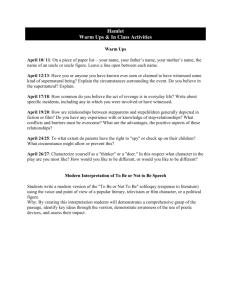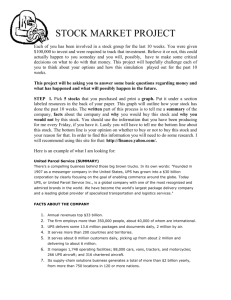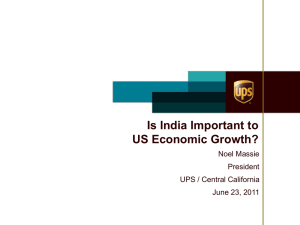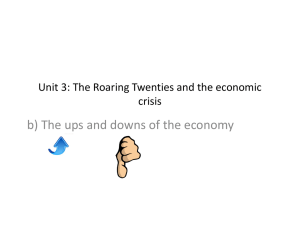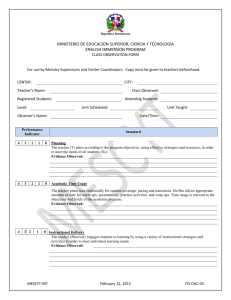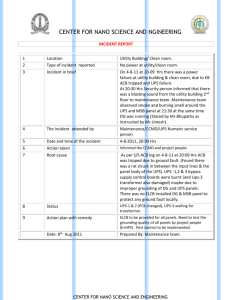广东外语外贸大学国际工商管理学院 《组织行为学》考试模拟题答案
advertisement
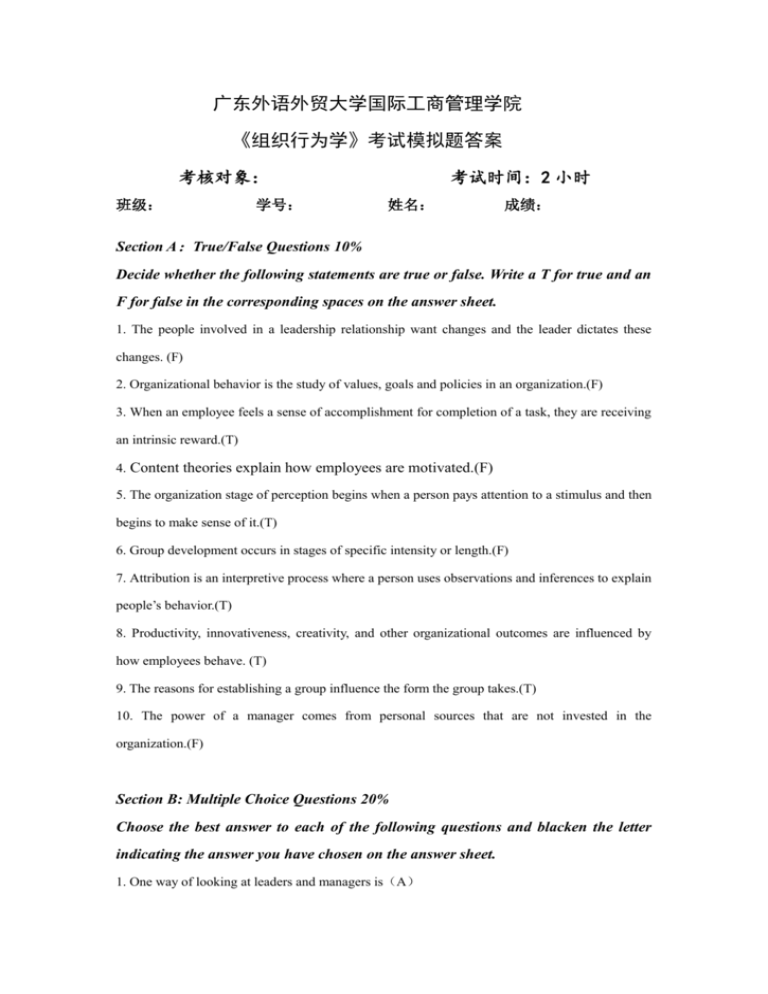
广东外语外贸大学国际工商管理学院 《组织行为学》考试模拟题答案 考核对象: 班级: 学号: 考试时间:2 小时 姓名: 成绩: Section A:True/False Questions 10% Decide whether the following statements are true or false. Write a T for true and an F for false in the corresponding spaces on the answer sheet. 1. The people involved in a leadership relationship want changes and the leader dictates these changes. (F) 2. Organizational behavior is the study of values, goals and policies in an organization.(F) 3. When an employee feels a sense of accomplishment for completion of a task, they are receiving an intrinsic reward.(T) 4. Content theories explain how employees are motivated.(F) 5. The organization stage of perception begins when a person pays attention to a stimulus and then begins to make sense of it.(T) 6. Group development occurs in stages of specific intensity or length.(F) 7. Attribution is an interpretive process where a person uses observations and inferences to explain people’s behavior.(T) 8. Productivity, innovativeness, creativity, and other organizational outcomes are influenced by how employees behave. (T) 9. The reasons for establishing a group influence the form the group takes.(T) 10. The power of a manager comes from personal sources that are not invested in the organization.(F) Section B: Multiple Choice Questions 20% Choose the best answer to each of the following questions and blacken the letter indicating the answer you have chosen on the answer sheet. 1. One way of looking at leaders and managers is(A) A. managers promote stability, leaders promote change. B. managers promote change, leaders promote stability. C. leaders promote both stability and change. D. neither managers nor leaders are involved with change. 2. An intermittent reinforcement can be of a ratio or interval type. The commission received by salespeople is basically a (D). A. fixed-interval reinforcement schedule B. fixed-ratio reinforcement schedule C. variable-interval reinforcement schedule D. variable-ratio reinforcement schedule 3. Which item doesn’t belong to content theory of motivation (D). A. Maslow's hierarchy of needs B. Two Factor Theory C. McClelland Achievement Motivation Theory D. Equity Theory 4. Who is the transformational leaders? (A) A. Jack Welch B. Adolf Hitler C. Benito Mussolini D. R. R. BlAke 5. According to Maslow's hierarchy of needs, the highest level of needs is (B). A. Physiological needs B. Self-actualization C. Esteem D. Safety needs 6. When we draw a general impression of the person being judged on the basis of a single characteristic, we may end up in distortions due to (B) A. selective perception B. Halo effect C. Stereotyping D. Contrast effect 7. Which is NOT the appropriate way to select employees? (C) A. interviews B. background checks C. employment tests D. nepotism 8. Acoording to Life Cycle Theory of Leadership, the style of leadership is determined by the maturity of subordinate. The maturity is based on (C). A. age B. physical C. psychological D. working experience 9. An important aspect of leadership is that (D) A. leaders are leaders and followers are followers, they are never the same person. B. leaders are somehow different, they are above others. C. leadership only emerges from the top of the organization. D. leaders and followers may sometimes be the same people, playing different roles at different times. 10. The only area of possible disagreement between MBO and goal-setting theory relates to the issue of (A). A. participation B. specification C. feedback D. challenge Section C: Essay Questions 40% Please briefly answer these questions. 1. What is the acquired needs theory? Which need appears to predict entrepreneurs? Answer: • Acquired needs theory proposes that certain types of needs are acquired during an individual’s lifetime. As with all content theories, an unsatisfied need motivates. • Need for achievement—the desire to accomplish something difficult, attain a high standard of success, master complex tasks, and surpass others. • Need for affiliation—the desire to form close personal relationships. • Need for power—the desire to influence or control others. • High need for achievement appears to predict entrepreneurs. 2. Is there a difference between leaders and managers? Answer: The text notes a difference between leaders and managers. A major difference centers on their source of power. Leaders gain power through their personal sources while managers are given power by the organization. Also, leaders usually promote change while manager promote the status. 3. Outline the assumptions about employees identified as Theory X and Theory Y. Answer: • Theory X assumes workers dislike their work and must be coerced into doing it. • Theory Y assumes that work is a natural part of employees’ lives and that employees will be industrious and creative if they are committed to their work. 4. What are instrumental and terminal values? How do values and attitudes relate? Answer: • Instrumental values are beliefs about the types of behavior that are appropriate for reaching goals. • Terminal values are beliefs about which outcomes are worth trying to achieve. • Attitudes are considered to have three components: cognition, feelings, and behavior. The cognition component includes the beliefs and values of a person. Therefore, one’s attitude is usually grounded in one’s beliefs or values. Section D: Case Analyses 30% Read the following cases and answer the questions. 1. CHET CADIEUX, CEO OF QUIKTRIP Chet Cadieux is the CEO of QuikTrip (QT), a $4 billion privately held firm in Tulsa, Oklahoma, that operates more than 460 convenience stores in nine states and has sales of more than $2.8 billion. It has been listed as one of Fortune’s 100 best places to work several times. Turnover rates of its employees are less than 15 percent in an industry where the average turnover is greater than 100 percent. Recently, QT received more than 118,000 job applications for less than 300 jobs. Its stock price has averaged a 17 percent increase in the past years. How has QT achieved these remarkable figures? First, Cadieux has a clear vision of the competencies his employees need to possess. Some of the key competencies include the ability to work in teams, the ability to learn from others, and an appreciation for diversity. QT puts applicants through a personality assessment designed to reveal how patient and how extroverted they are. If an employee has the right personality, shoppers will sense that when they enter the store. Employees will enjoy working at QuikTrip and will like each other. Second, once the new person is hired, they are assigned a partner who has held the same position previously. These two work the same shifts and perform the same duties. Cadieux believes that this allows the new employee to interact with their peers and get a sense of the pace of work in a busy store. Third,promotions come from within. More than 400 store managers and every top executive started working at a store, stocking shelves, greeting customers, making coffee, etc. Cadieux believes that this fosters teamwork and managers who have empathy for their employees. Front-line managers also have role models to follow. Fourth, Cadieux has created fringe benefits packages that are tailored to employees’ needs. For example, depending on a person’s tenure, employees’ receive 10 to 25 days of vacation, plus 10 days of sick leave, and they can purchase up to an extra two weeks of vacation. Cadieux has structured a customer service-appraisal system that focuses on the team’s performance in satisfying and delighting customers. He employs mystery shoppers who visit stores and report on its service. If the mystery shopper is particularly impressed with an employee, all employees during that shift receive a bonus because he believes that individual rewards would undermine his belief that all employees contribute to the customer’s experience. He writes a personal note to the employee thanking him or her for outstanding service. He also tells employees that they will not be fired for well-meant mistakes. He wants to encourage employees to be innovative and take risks. He doesn’t want to let the fear of a mistake stifle innovation because employees are often the most important source of new product ideas. Question: what kind of knowledge/theory does the case illustrate? Answer: The Preview Case illustrates the importance of how a manager’s perceptions of his employees influence their behavior. People base their behaviors on what they perceive, not necessarily on what reality is. People shop at QuikTrip because of the experience they enjoy while shopping. Cadieux has recognized the difference between the perceptual worlds of their customers and the competitive nature of this industry. 2. UPS Steve Menkhaus, a UPS delivery driver in Sharonville, Ohio, didn’t see himself as a salesperson. However, since UPS began a sales lead incentive program in 1993, more than 100,000 delivery drivers have generated more than a half a million sales leads. After a driver initiates a lead, a UPS representative follows up, usually in a day, with additional information and a contract offer. Forty-three percent of these new sales leads have turned into new customers, generating millions in new company revenue. Menkhaus’s efforts in the sales lead incentive program not only added new business for UPS, but they also enabled him to accrue points that he could exchange for merchandise and trips. What Menkhaus did sounds simple, but it represents a dramatic and fundamental change in the way UPS motivated its drivers. The need to change was fueled by competitors, such as the U.S. Postal Service, Emery, and DHL, all of which expanded their services to attract UPS customers. Offering customized and convenient services, each competitor chipped away at UPS’s business as they carved out their own niches. To respond to the competition, UPS cut costs by offering an early retirement program to managers, which many took. This program left UPS with fewer managers and put more demands on front-line employees, such as Menkhaus. UPS’s motivation plan was to involve each employee in soliciting new business. In essence, UPS was entrusting nonmanagement people with determining the best ways to attract and serve customers. Most of the drivers embraced their new autonomy and saw tremendous opportunities to get valued rewards. Before UPS turned its drivers into salespeople, it gave each driver tips on selling. UPS drivers were allowed to spend up to thirty minutes per week of unstructured time on the job. [Remember, this is a company that scheduled its drivers to the tenth of an hour and told them how to carry the clipboard (under the right arm) and the package (under the left)]. As a result, drivers can now spend more time with customers—to listen and to come up with solutions to meet their needs. Thirty minutes a week may not sound like much, but it is a huge financial commitment. At $29 per hour, UPS drivers are the highest paid in the nation. For UPS, thirty minutes per week per driver means a commitment of approximately $36 million a year. What have been the results? Revenues have exceeded $35 billion and profits were up substantially. UPS handled more than 13.7 million packages a day, the best in the history of the company. Recently, UPS has set a goal to become the number one supply chain company in the world. To accomplish this goal, UPS has aggressively acquired other logistics companies and has started to manage the in-house supply chain operations for customer companies. For example, Nike uses UPS to handle its entire supply chain. Every few hours, Nike sends a batch of orders from Nike.com to a UPS facility in Louisville, Kentucky. Within a few minutes, a UPS employee, using a radio-frequency bar-code reader, grabs the item—usually made in Asia and delivered directly to a UPS warehouse located by a major airport—off the shelf. The product is then checked by another UPS employee for accuracy, packed, and shipped within 24 hours to the store. Questions: 1. Why can UPS become one of the largest package delivery companies in the world? 2. What’s the relationship between a company’s culture and its success? Answer: 1. Menkhaus’s efforts in the sales lead incentive program not only added new business for UPS, but they also enabled him to accrue points that he could exchange for merchandise and trips.To respond to the competition, UPS cut costs by offering an early retirement program to managers, which many took. This program left UPS with fewer managers and put more demands on front-line employees, such as Menkhaus. UPS drivers were allowed to spend up to thirty minutes per week of unstructured time on the job. UPS has aggressively acquired other logistics companies and has started to manage the in-house supply chain operations for customer companies. 2.Culture is the key to success.


